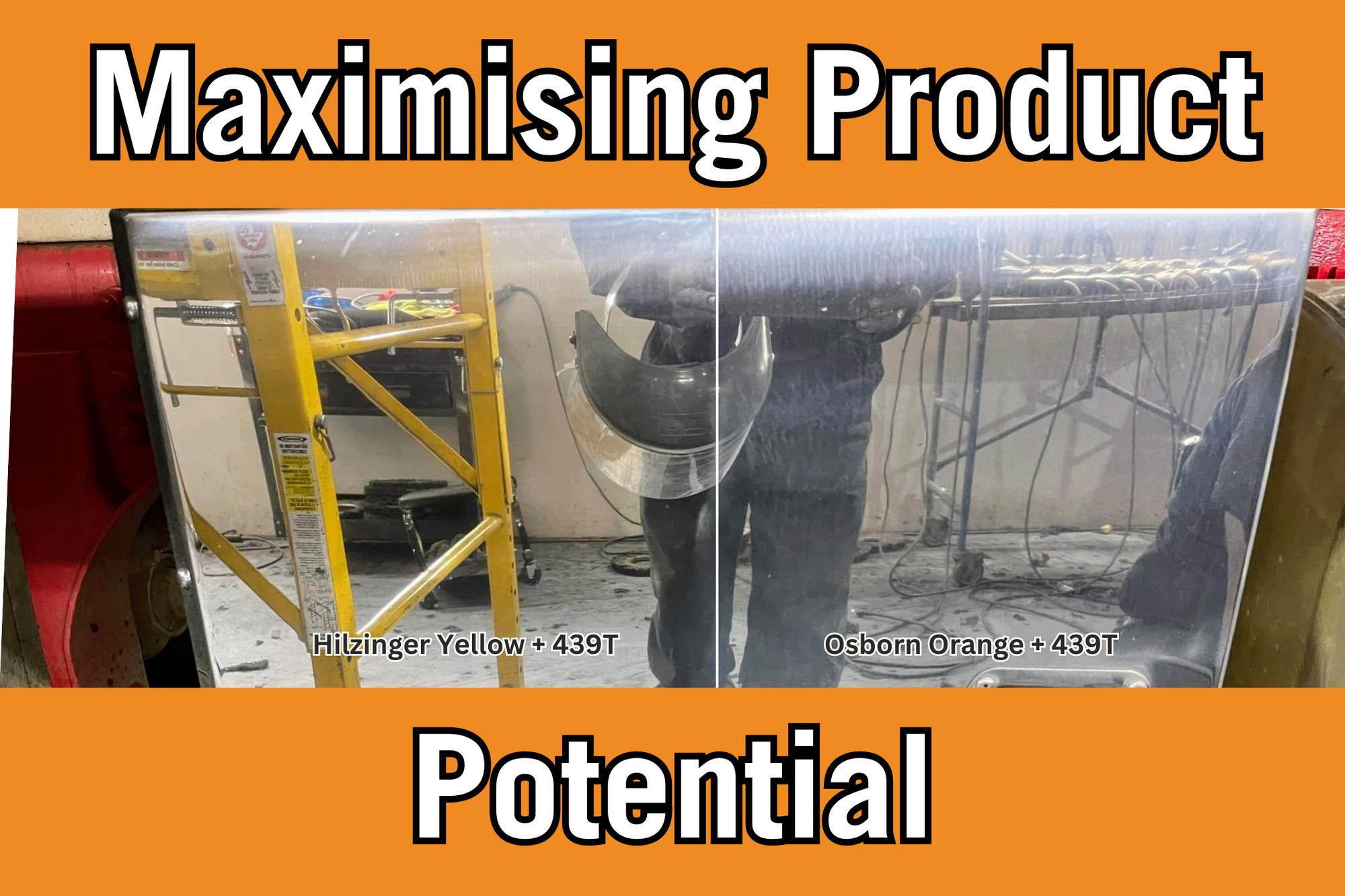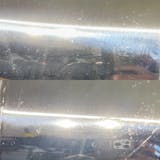I want to discuss polishing products and their "potential". I'm going to try to be very general as this isn't going to be data-driven and scientific but a theoretical discussion of how different combinations of products bring out different characteristics and potential finishes. TL;DR: the performance of your high quality buffs or compounds can be limited by the lower quality products you pair with them.
There are a few constants in polishing: one of which is is that polishers are frequently in one of two camps.
- They've used the same things for decades and (claim) they never plan on changing (because they actually do try new things occasionally, but expect them to work exactly the same as their old product, and give up on them the second they don't);
- They are looking for that next great thing to tone down their hash or speed up their process a little more.
For example, a lot of our customers started their journey in metal polishing using a well-marketed or widely available brand, but see others getting better results than them and they assume it's a problem with one or more of their products (it can be, but isn't always). They hop into a Facebook group and ask, "I'm using "X", what is better?" and everyone under the sun - with some polishing experience or none - will pile in to share whatever latest thing they've tried or heard about someone trying. Some are even paid (in cash, or in discounted products) to plug a brand, whether they truly believe what they are saying or not.
Despite the costs of shipping, however, most are not comfortable trying a *lot* of new things at the same time, and they end up buying one or two of another brand's buffs - or compounds - to try alongside their old standards.
Let's consider an idea:
- Every product you use has a cutting factor "potential" and a finishing potential - in other words, it can achieve a certain maximum cutting power or finish quality when paired with the right buffing wheel / compound / situation.
- Menzerna used to provide an internal rating system for how aggressively a compound would cut compared to their other products (when paired with an aggressive buffing wheel on the appropriate metal) and how finely it could finish with a gentler buffing wheel.

- Pairing different buffing wheels with a given compound can produce very different results, but there are trade-offs involved.
- A cut buff will tend to have more weight, firmness, a more coarse treatment, and other factors (discussed in other posts) that results in a faster cutting action.
- These factors, however, tend to result in more buffing lines ("hash marks").
- You can improve the finish produced by your cutting compound by utilizing a less coarse/less firm/lower thread count (etc.) buffing wheel but you will generally spend more time removing the same amount of material to level your surface.
- The benefit is that you will spend much less time removing your cutting "hash".

High quality Hilzinger yellow mill treat (medium) airway + high quality Menzerna 439T Heavy Cut VS. Osborn orange mill treat (firm) airway + 439T
There are other limiting factors (some more difficult to control, like temperature, humidity, alloy purity/mixture, etc.) but perhaps most important are the quality of your products and the skill / knowledge / experience of the end-user. Let's dive into these ideas...
For example, let's compare the potential of two cutting compounds. This is simplified: one may simply have a more aggressive cut and/or cleaner resulting finish, but it may also:
- allow a longer working time (hold compound/stay on the buff longer);
- require less product to get a finished result;
- remove scratches rather than simply fill and hide; and ultimately
- get a finished result more quickly (time is money).
These are important factors but not practical to compare all at once in a simple bar chart.

Different buff types and their potential finish with two different cut compounds. The cut buff will get the maximum potential cut out of both compounds, but only a bit more than half of the finishing potential of cut compound #1. A cut & colour buff will get most of the cut potential out of both compounds and the maximum finishing potential out of both compounds. The finishing buff will get maximum finishing potential out of both compounds but less than half of their cutting potential.
Cut Compound #1 appears to be of generally higher quality because it potentially produces both a more aggressive cut and cleaner (higher gloss) finish in a single polishing step. Buff choice will, however, dictate the potential cut and finish of each compound.
- The cut buff will achieve the maximum cut of both compounds (8/10 and 7/10, respectively), so in theory Compound #1 will perform a bit better in terms of cut efficiency.
- It will, however, not finish at maximum potential due to the aggression of the buff; as a result Compound #1 will appear to finish only slightly better than Compound #2 (3/10 and 2/10 respectively).
- Using a cut & colour (medium) buff, neither compound will achieve maximum cut (limited by the buff to 6/10) so cut performance will be similar; however, this buff will maximize the finish potential of both compounds and highlight the substantially better finishing potential of Compound #1 (5/10 vs. 2/10).
- Using a finishing buff, the finishing potential of both compounds would be maximized (5/10, 2/10) but at the cost of a significantly slower cut in both cases (3/10).
To introduce another factor: what if we use a lower quality buff (e.g., firmness is lost quickly, less heat resistance, reduced compound retention, wears more quickly, etc.) with our compounds?

The higher quality buff will maximize the cutting potential of both compounds, whereas the lower quality buff will limit the cutting potential and make the compounds appear to perform more similarly than they otherwise would. Similarly, the finishing potential of the lower quality buff reduces the difference in finishing capability of the two compounds.
As seen above, a lower quality cutting buff could reduce the potential cutting action of both compounds but limit the finish capability of the higher quality compound, making them perform (in the most obvious ways) more similarly than they otherwise would:
- Buff 1 + Compound 1: 8/10 cut, 3/10 finish
- Buff 1 + Compound 2: 7/10 cut, 2/10 finish
- Buff 2 + Compound 1: 6/10 cut, 2/10 finish
- Buff 2 + Compound 2: 6/10 cut, 2/10 finish
In other words, not only does the lower quality buff make the two compounds appear to perform more similarly than they otherwise would, it may in fact be holding back the full potential of the lower quality compound!
Finally, experience / knowledge / technique / skill comes in. This can have a significant effect even with a highly experienced / skilled polisher, simply because a product may work in a much different way then they are used to with their current products (i.e., they need to experiment and break habits to achieve a product's maximum potential).
- For example, we frequently see this with Menzerna compounds like 439T Heavy Cut as many end users compensate for their buffs' ability to hold compound and their compounds' working time by applying a lot compound with a long application to the buff (even spraying excess on to the workpiece).
- Overapplication with a tacky compound like 439T can actually reduce its cutting performance by creating a situation where the buff has been over-lubricated.
- This effect can be exacerbated by our new premium Hilzinger buffs due to their slower wear and enhanced compound retention, particularly once broken in. They simply need a shorter application of compound to achieve the same amount of work!

User experience (if visualized as a multiplier) can also reduce the experienced results of different combinations of products.
In the final example above, you can see that a quality finishing buff (#1) and compound (#1) can achieve a 9/10 finish potential; the lower quality buff (#2) would limit the finish capability of compound #1 to 7/10 and maximize the lower quality compound's (#2) 6/10 finish potential.
If we visualize experience / skill as a multiplier (e.g., 0.7x), it may affect all products equally (although, as discussed above, not always since users usually have more experience with one product than another) but result in even smaller differences in performance.
- For example, when maximum performance is assumed, Buff #1 used with Compounds #1 and #2 results in 9/10 and 6/10 finishes (difference of 3 points);
- When the multiplier is applied, both final scores are lower but also closer together (6.3/10 and 4.2/10, a difference of 2.1 points).
- Using lower quality Buff #2, the difference becomes even smaller: 7/10 vs. 6/10 (1 point) becomes 4.9/10 vs. 4.2/10 (0.7 points).
The benefits of pairing high quality products (compounds, buffs, sandpaper, tools, etc.) are clear - but if the potential returns are smaller for less experienced individuals, should they invest in higher quality product to begin with?
That may depend on their individual situation (how many projects they intend to work on, how large the projects are, whether they prefer to save cash or save time - e.g., if it's a small one-off project without high expectations, it can make sense to get by with lower up-front cost products) - but keep in mind: this means that higher quality products will give you greater returns as you learn and improve. And you won't have to waste the same time re-learning how to do things if you don't learn counter-productive habits using lower quality products at the start!
- If you purchase low quality products, get a ton of advice from others, and practice hard - you may be discouraged by small gains in results.
- If you purchase quality compound and pair it with a poor quality buff, your potential gains will be limited because the buff may limit the potential of your compound no matter how skilled you become - and you may not realize it if you've never seen better!
- In contrast, a top quality buff may bring out potential of your old standby compounds, or it may appear to add little simply because the compound's potential had already been reached.
A lot of people have become jaded by photos and videos of end-results they've seen online; experienced polishers know well that lighting and photo angles can drastically reduce the appearance of buffing lines, and when they see amazing results they frequently assume there are tricks involved because they have never achieved the same (except by taking skewed pictures).
- They might try a new compound only to find it makes less of a difference than they thought it would because they are still using a lower grade buff, or they haven't practiced extensively with a product that otherwise behaves differently than anything they've experienced before. Familiarity and ease of use is comforting, and learning new ways of doing things can be challenging.
We can honestly say that despite a long career in the metal finishing industry - and (now) years of experience using Menzerna compounds - our partner Stephane and his team are still learning new things every day about how to get the most out of these products, especially since pairing them with Hilzinger premium buffing wheels. More importantly - despite the test of time - they find they get significantly better results in less time with their current lineup of products than they ever did with their old favourites (and they sometimes grab them on the shelf to put them to the test, just to be sure!).



1 comment
Awesome read from a very accomplished team of guys.